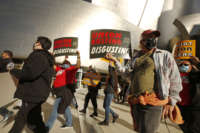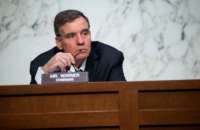Kroger, the major grocery chain, has pointed to its connections with local growers to defend a recent proposed merger. But one of those growers has been linked to a huge human trafficking scheme to maintain a steady supply of exploited farmworkers.

Multibillion-dollar retail giant Kroger Company defended its proposed takeover of rival Albertsons Companies, Inc. by highlighting its partnership with a blueberry grower that hired a labor contractor accused of orchestrating one of the largest human trafficking rings in modern US history.
Though the blueberry grower in question, Southern Press and Packing, is one of many suppliers that work with the grocery giant, the situation spotlights merger opponents’ claims that Kroger has failed to guarantee minimum standards for workers in its supply chain — a situation they say could worsen if the company is allowed to grow exponentially larger.
“As it is, Kroger is not doing what they should as a very powerful corporation,” said Lupe Gonzalo, a staff member for the farmworker-led human rights group the Coalition of Immokalee Workers (CIW), which has helped expose human trafficking cases involving more than 1,200 migrant workers. “Imagine them as an even more powerful company [and] not using that power to grant human rights to workers in their supply chain.”
Federal regulators have been evaluating the proposed merger and are expected to soon decide whether they will oppose it.
In September, while pledging to increase the number of local products in its stores if the merger went through, Kroger touted four local growers by name out of 1,500-plus suppliers nationwide. One of those was Georgia-based Southern Press and Packing, an eighteen-year-old business that sells blueberries and manufactures a juice brand called Regenerate that at one point was offered in a majority of Georgia public schools.
“From Stemilt cherries in Washington and Sun Pacific citrus in California to Talbott Farms Palisade Peaches in Colorado and Southern Press blueberries in Georgia, we know just how important local products are to our customers,” said Kroger senior vice president Stuart Aitken in the release. “We are excited to provide more opportunities for local producers to grow their businesses.”
According to public records, Southern Press hired Maria Leticia Patricio’s labor contracting firm to find dozens of seasonal employees to work in its fields for much of 2020. Less than a year later Patricio was indicted as the alleged ringleader of a $200 million human trafficking ring.
Prosecutors claim the “Patricio transnational criminal organization” subjected dozens of Mexican and Central American workers to “modern-day slavery” by holding their identification documents hostage, forcing them to work for little or no pay, subjecting them to dangerous living conditions, and threatening them and their families with deportation and violence. The indictment states that those involved in the operation kidnapped, threatened at gunpoint, and repeatedly raped some of their victims, and that at least two people died because of the working conditions.
Patricio, who is awaiting trial, has pleaded not guilty to the crimes.
Kroger, including company CEO Rodney McMullen, did not respond to multiple emails and phone calls seeking comment. When reached by phone and asked about contracting with Patricio in 2020, a representative for Southern Press, office manager Amy Nimmer, said that its CEO “does not recognize that name at all,” and did not respond to a question about contracting with Patricio’s company, Rojas Avila Harvesting LLC. Southern Press also did not respond to a list of questions emailed by us.
Barry Paschal, a representative for the US Attorney’s office in Savannah, Georgia, responded to an inquiry about Patricio’s case by referring us to the public record.
At least three other Kroger suppliers have also been accused of profiting from human trafficking and systemic wage theft since October 2021. One case has led to multiple criminal convictions; another involves more than $200,000 in fines and penalties for wage theft.
In December, US senator Ron Wyden, an Oregon Democrat, urged the Federal Trade Commission (FTC), the regulatory agency reviewing the proposed merger, to attempt to block the deal. Among other concerns, Wyden suggested in a press statement that the consolidation could result in “fewer economic opportunities for Oregon’s small farmers.”
Last summer, the FTC said that it would analyze the proposed merger’s effect on “farming” among other supply issues. As part of the agency’s ambitious new efforts to crack down on corporate monopolies, officials warned they can sue to stop any merger that stymies labor market competition. The FTC is expected to announce its decision on litigation by January 17.
California attorney general Rob Bonta has also vowed to examine the merger’s likely impact on agriculture. He is one of three state attorneys general considering lawsuits to stop the deal.
Critics say Kroger doesn’t have meaningful controls to disqualify abusive vendors and contractors. For years, the corporation has failed to join the Fair Food Program, an independent workplace standards compliance program founded by CIW, which requires suppliers to pay wage premiums and abide by a code of conduct with enforcement mechanisms like audits and whistleblower hotlines. Other major corporate retailers participate in the program, including Trader Joe’s, Whole Foods, and Walmart.
“Modern-day slavery and forced labor are effectively nonexistent in these Fair Food fields,” noted a June 2023 Harvard Law School report on the program’s efficacy, which found that farmworkers covered by Fair Food agreements receive 60 to 100 percent higher pay.
Troubling Crop Patterns
The partnership between Southern Press and Kroger dates back to at least 2016, when the blueberry company’s CEO appeared in a TV commercial for the grocery chain.
In the ad, Southern Press CEO Shawn Davis boasts of his company’s devotion to fresh produce between rows of blueberry bushes in the Georgia sunshine.
“Sometimes, within four to five hours, we have the fruit out of our fields and into our customers’ hands,” Davis said.
But the ad’s farm-to-fork romance clashes with the experiences of many wage laborers who make US farms productive, especially the migrant workers brought to the country through the alleged human trafficking ring that Patricio reportedly helped orchestrate.
Patricio, one of twenty-three individuals indicted for the alleged racket, is accused by federal prosecutors of leading the group’s efforts to apply for seasonal visas for more than seventy-one thousand migrant workers through a temporary work visa system for the agriculture industry called the H-2A program.
At the time, Patricio’s brother Jorge Gomez worked as Georgia’s Department of Labor’s State Monitor Advocate, meaning he was in charge of advocating for migrant farmworkers and managing all related worker complaints and housing inspections. Law enforcement hasn’t accused Gomez of wrongdoing, but during the investigation a federal agent testified that Georgia labor officials were bribed as part of the criminal enterprise, and officers searched Gomez’s home.
Growers and contractors can apply to sponsor H-2A visas if they can show the US Department of Labor that they “anticipate a shortage of domestic workers.”
Worker advocates say many of those granted entry on H-2A visas — about 90 percent come from Mexico, many from impoverished rural areas — are vulnerable to human trafficking because their immigration status and housing are tied to their employment. In 2019, a survey conducted by the migrant worker advocacy group Centro de los Derechos del Migrante found that 32 percent of H-2A workers “did not feel free to quit,” while 34 percent “experienced restrictions on their mobility.”
Growers and contractors are required to reimburse workers for travel costs, but many employers use debt and deportation threats as tools of coercion, which is what happened in the Patricio case, according to federal prosecutors.
Industry advocates say that the H-2A program is essential for keeping family farms afloat when they can’t find other workers, but a recent investigation by us revealed that it’s not just family farms — billionaires and institutional investors also sponsor H-2A farmworker visas.
In February 2020, the US Department of Labor posted a job listing for a labor contracting company registered under Patricio’s name that sought H-2A visas for seventy-four workers for “all general farm labor related to: blueberries.” A related filing listed Southern Press as their destination.
Another labor contracting company registered under Patricio’s name applied to sponsor seasonal visas for 148 workers in 2019 and2020, in filings that listed an address associated with a company called Creekside Berry Farms. Creekside Berry Farms is co-owned by a former Southern Press executive.
Around the time Patricio was finding workers for Southern Press and Creekside, she allegedly played a critical role in a scheme that netted its participants $200 million in profit, according to federal prosecutors.
Prosecutors meticulously detailed the alleged racket. Their charging documents state that the operation, which started in November 2015, was built on “thousands” of trafficked H-2A workers performing backbreaking tasks for little or no money, sometimes at gunpoint. Prosecutors said that two workers entrapped in the scheme died on the job, and others were repeatedly raped or forced to live in squalid, cramped trailers or “in a work camp surrounded by an electric fence.”
The Georgia-based operation allegedly stretched into other states and across the US border in Mexico, Guatemala, and Honduras. According to prosecutors, such activities included the unlawful sale of “approximately thirty workers to a conspirator in Indiana for $21,481.” Conspirators were said to have laundered millions buying land, houses, and businesses in cash and funneling gains through a Florida casino.
The indictments came after a multiyear investigation involving more than two hundred law enforcement officials codenamed “Operation Blooming Onion,” after the onion fields where some of the alleged victims worked. Investigators claim to have identified at least 102 victims of the defendants in southern Georgia.
Again, Patricio has pleaded not guilty to her role in the alleged conspiracy, and her trial hasn’t started yet. But last fall, four of the twenty-three individuals alleged to have conspired with Patricio pleaded guilty to some of the crimes, for which they received jail sentences ranging from one to two years and were ordered to pay victims hundreds of thousands of dollars in restitution. What’s more, in March 2022, three men were convicted in a related case, and one of them was sentenced to thirty years in prison.
This isn’t the only instance in which Kroger suppliers have been associated with alleged labor law violations.
In October 2021, Mastronardi Produce, a tomato supplier for Kroger and other major retailers, was blocked from importing a shipment from Mexico after US customs officials accused “two large Mexican agribusinesses,” including one of Mastronardi’s partners, “of forced labor abuses,” according to the Los Angeles Times.
In 2022, four Florida residents working for Los Villatoros Harvesting LLC, a Kroger and Walmart watermelon supplier, pleaded guilty to charges related to a “conspiracy to subject [over a dozen] migrant farmworkers to forced labor,” according to the Department of Labor.
And in September, labor officials revealed that a Kroger supplier, Colorado-based grower Star Farms, was under investigation after owner Angelo Palombo was accused of wage theft, and of refusing to provide his H-2A workers with clean water and sanitary bathrooms.
Palombo has also racked up at least $209,000 in back-wage payment orders and fines for violating federal labor law over the past two decades, the Denver Post reported.
Refusing a Proven Solution
According to Kroger, the company has established “a Zero Tolerance policy for human rights violations like child labor, forced labor, discrimination, and safety violations such as blocked exits.”
“If suppliers do not live up to our Code [of Conduct],” the policy states, “we will not do business with them.”
But Kroger has never disclosed information about the enforcement of its code, including information about in-person audits of suppliers, worker interviews, and grievance resolution mechanisms, according to Domini Impact Investments, an activist mutual fund.
The fund, which uses shareholder advocacy as a tool to try to force corporations to be more socially responsible, made the allegations in a shareholder proposal from 2022, which called “modern-day slavery . . . a risk for Kroger.” The proposal cited the Patricio racketeering case, the Mastronardi incident, and a guilty plea in the case involving the watermelon supplier.
“Even though they say they’re protecting workers rights, that’s not really what’s happening through this policy,” said CIW’s Gonzalo. “In the last few years, we’ve seen a number of modern-day slavery and forced labor cases where Kroger has bought from suppliers, which are places that, according to their policy, they shouldn’t be buying from.”
The Domini proposal called on Kroger to remedy the problem by joining CIW’s Fair Food Program. Under the program, which was established in 2011, participating suppliers subject themselves to audits and site visits by the Fair Food Standards Council, a body created to enforce program rules.
Workers on farms that participate in the Fair Food Program are informed of their rights through on-the-clock educational sessions. They are also able to report rule violations to a twenty-four-hour hotline staffed by the Fair Food Standards Council. Suppliers who repeatedly violate the rules are expelled. Growers that comply with the program’s rules receive a premium from participating buyers.
The premium has delivered $44 million to participating farms since 2011, at least 87 percent of which goes directly to workers, according to the Fair Food Standards Council. The council also says it has resolved thousands of worker complaints, recovering roughly $500,000 in lost wages in the process.
“This is a program that has been recognized, it has been shown to work to protect workers rights, and it’s really one of the only programs that is protecting workers in this way,” said Gonzalo, who first experienced the program’s benefits as a farmworker herself.
“It was a real change,” she said. “We had a voice to report problems that we might have, a voice to report sexual harassment. It was completely different.” Gonzalo now does educational outreach for the Fair Food Program, following in the footsteps of the staffer who first told her about the program in 2011.
“It woke up my interest,” she said. “Before this, I had never heard about our rights, or an organization that was protecting our rights. Particularly as a woman working in the fields confronting sexual harassment, there hadn’t been anything you really could do about that.”
Kroger has not joined the Fair Food Program, and refused to let its shareholders vote on the Domini proposal. Last year, in its petition to the Securities and Exchange Commission to allow it to exclude the proposal from shareholder proxy voting materials, the company noted, “The Proposal, if adopted, would . . . hinder management’s fundamental ability to run the company’s day-to-day operations.” In April, the commission granted the exclusion.
Albertsons also doesn’t participate in the Fair Food Program, though the company has demonstrated some concern about vendor malfeasance. Safeway, a grocery store owned by Albertsons, dropped Star Farms as a supplier in October after the Denver Post reported on the farm’s record. Kroger made no such commitment.
And in regards to the Mastronardi case, Walmart and Albertsons declined to respond to specific questions about their reliance on the tomato supplier. But a spokesperson for Kroger, when asked by the Los Angeles Times if the company had used Mastronardi in the past year, replied: “Not to our knowledge.”
Kroger’s response was cited by the Domini shareholder proposal, which noted that Kroger “may lack adequate oversight or be ineffective at addressing forced labor and other human rights abuses,” exposing the company to “to legal and reputational risk.”
“A Threat to Farm Suppliers”
In October 2022, Kroger, which is headquartered in Cincinnati, Ohio, and made $2.2 billion in profit that year from 1,200-plus grocery stores in sixteen states, formalized its $24.6 billion proposal to takeover Albertsons, which made $1.6 billion that year. The takeover, which needs to be approved by regulators, would result in Kroger’s market share jumping to about 22 percent of the entire US grocery industry, second only to Walmart.
If regulators reject the merger proposal, Kroger can appeal the decision to the federal judiciary, which has been skeptical of FTC antitrust actions during the Biden administration.
Stop the Merger, a broad coalition of advocacy groups opposed to the deal, has warned on its website that the resulting company would “no doubt create a monopoly in the grocery industry, leading to store closures, thousands of lost jobs, and higher food prices.”
The group has also warned that “the merger also poses a threat to farm suppliers.” Economists have found that a reduction in competing wholesale buyers puts downward pressure on wages throughout the supply chain. Studies, for example, have shown the widespread drag on wages caused by Walmart’s market power.
If agricultural suppliers are squeezed as a result of the Albertsons takeover, farmworkers will undoubtedly bear much of the pain. Agricultural employees don’t enjoy most federal workplace protections and are paid some of the lowest wages in the United States, despite being considered essential labor.
Workers advocates say the Patricio case exemplifies how for migrant workers on H-2A visas, the situation can be even worse.
“As long as there aren’t protections for workers, and workers are afraid to speak up, there are most likely going to be cases of forced labor,” Gonzalo noted. “There are going to be women who are victims of sexual harassment because they don’t have the protections necessary. Companies like Kroger can do a lot to change that and they haven’t.”
You can subscribe to David Sirota’s investigative journalism project, the Lever, here.
This post was originally published on Jacobin.

















